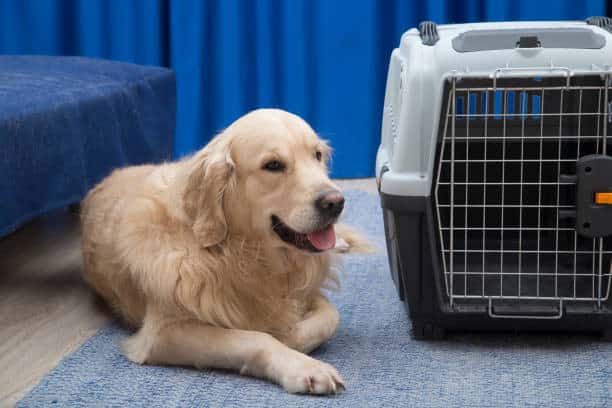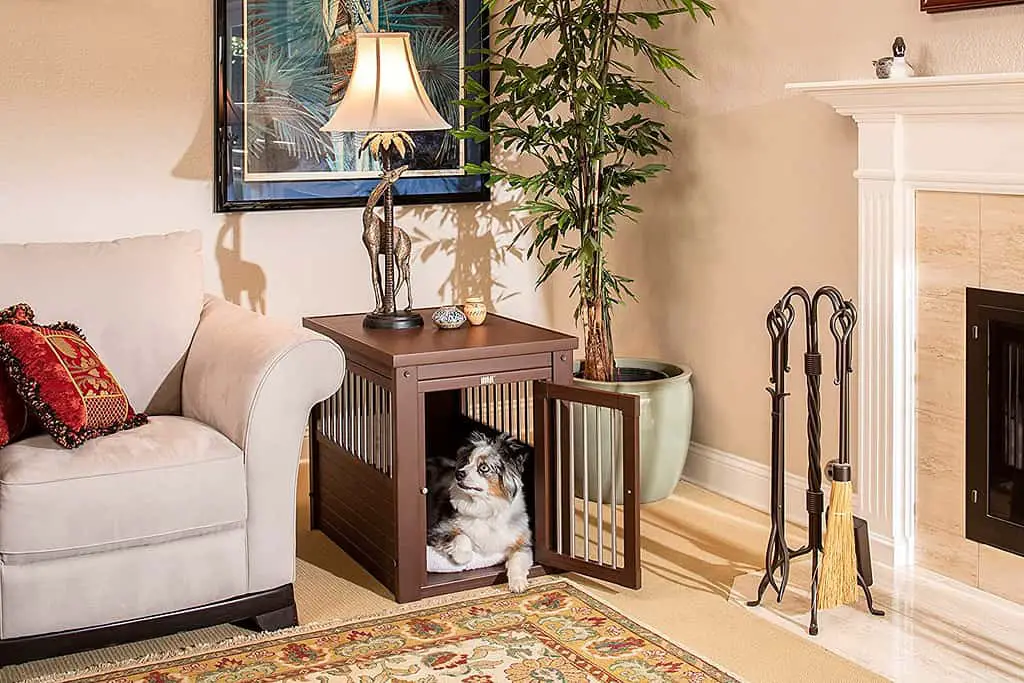When selecting a crate for a Labrador Retriever, bigger is usually better as long as it is not too large. The ideal crate size allows your Lab to stand up, turn around, and lie down comfortably. For most adult Labrador Retrievers, a 42-inch crate length is needed. The crate width and height should be enough for them to sit and stand comfortably.
Too big crates don’t restrict your Lab’s movement and defeat the purpose of crate training. The right crate size for your Lab depends on their height and weight. Measure your dog and choose a crate with some room to move but not enough to soil one end and sleep on the other. The crate should be their safe, cozy space.
What Size Crate Does A Lab Need?
Determining the appropriate crate size for a Labrador is crucial for their comfort, safety, and overall well-being. Labs have variations in size or subtypes, like English and American Labradors, but most adult Labs will require a 36-inch or 42-inch crate.
The chosen crate must allow your dog enough space to sit, lie, and turn around comfortably. The Humane Society supports this notion that a dog’s crate should provide ample room for these basic movements. If you have a particularly large Labrador or one that falls outside the typical size range, opt for an even more spacious 48-inch crate.
What Are the Benefits Of a Crate For A Labrador?
Crating a dog provides benefits such as promoting sleep and relaxation, providing space to watch them, and preparing for future travel.
Sleep And Relaxation
Providing your Labrador with a properly sized crate ensures a secure space to sleep and relax. Dogs seek den-like environments for rest, making crates ideal for creating that haven.
A well-designed crate promotes relaxation and helps reduce anxiety in dogs, especially during stressful situations like thunderstorms or fireworks. Labrador crates help maintain a consistent sleep schedule for most dogs.
Space To Watch Them
One of the benefits of using a crate is that it provides a designated space for your Labrador to relax. Moreover, it also allows you to keep an eye on them quickly.
This is useful during the early stages of crate training and when you must closely monitor your dog’s behavior or health.
Metal crates help with managing household dynamics among multiple pets. If you have other animals in the home, crating offers separation without completely isolating any pet.
Preparing For Future Travel
When traveling with your Labrador, using a dog’s crate helps keep them safe and secure during transportation. Always read up on airline cargo specifications and go for soft-sided crates during long trips.
My dog, for instance, was frightened during his first time aboard a plane. So, acclimatizing your sweet dog will take time. It’s normal. You would feel the same were you in his place.

Tips For Choosing The Right Size Crate For Your Lab
Buy An Adult Crate And Section It Off
When looking for the best dog crates, consider buying an adult-sized crate and sectioning it off. This will allow you to adjust the size of the crate as your dog grows.
Sectioning off a larger space more than what is needed can lead to accidents if your puppy has too much extra room and uses one end as a bathroom. In these cases, use a divider or partition panel with most adult crates or find one that fits perfectly with your particular model.
This way, you can restrict access until they become house-trained before gradually increasing the size of their available living space inside the crate.
Not Too Large
Avoid going too big. While giving them extra space may seem like a good idea, having too much room in their crate can make them anxious and insecure.
Your dog must have enough space to move but not so much that they feel overwhelmed. A correctly sized dog crate will provide your labrador a cozy and secure retreat.
Measure The Length of Dog Crate
To accurately measure their length, have your dog stand up straight and use a measuring tape to measure from their nose to where their tail begins.
Choosing a dog’s crate that is not too long or short is key. If it’s too short, your dog won’t be able to stretch out fully.
And one that is too long might encourage them to use one end as a bathroom area. The right-size crate will give them enough space to move freely and feel comfortable in their own space.
Measure The Height of Labrador Crates
It’s not just the crate’s length that matters when choosing the right size for your Labrador, but also the height. When measuring your dog’s height, ensure they stand up straight with their paws flat on the ground and head level.
The best labrador crates should be tall enough to stand comfortably without crouching or hunching. The best way to determine the correct height for your Labrador’s crate is to measure your dog’s height from the floor to the top of the head.
Once you have the measurement, add 3-5 inches to ensure your dog has enough room to stand up and turn around in the crate. Here are some of the most popular crate sizes for Labradors:
- Puppy crate: 24-30 inches high
- Small crate: 30-36 inches high
- Medium crate: 36-42 inches high
- Large crate: 42-48 inches high
Benefits Of Crate Training Labrador Retrievers
Crate training benefits Labrador Retrievers as it helps with house training, provides a cozy and relaxing space, and allows them to travel safely and comfortably.
The Best Size Dog Crate Is Cozy And Relaxing
Dogs naturally crave a safe and secure space to call their own, and a comfortable crate provides just that. Their designated area allows dogs to feel more comfortable in high-stress situations, such as thunderstorms or fireworks displays.
Also, your Lab can help them establish a routine and get better sleep at night. Another advantage of using crates for a labrador is that they provide an excellent way to safely transport your Lab on long trips or airplane flights.
Dog Crate Training Help With House Training
Crate training is very important due to its assistance in making labs house-trained. Dogs naturally avoid soiling their sleeping area and hold their bladder and bowel movements until they can be taken outside.
By confining them to a properly sized crate, you create an environment that encourages your Lab to control its elimination habits. This allows you to regulate their eating and drinking schedules and establish potty break routines.

A Crate Helps Your Labrador Puppies Travel
Crates provide a safe and secure space for your puppy to relax and sleep during travel. They can also help to prevent your puppy from becoming anxious or stressed during car rides. Here are some tips for crate training your Labrador puppy for travel:
- Start by choosing the right size dog crate for your pup. The crate should be large enough for your puppy to stand up and turn around but not so large that it can make a mess.
- Place the plastic crate in a quiet area of your home and put a comfortable bed or blanket inside.
- Leave the crate door open and allow your puppy to explore it independently.
- Once your puppy seems comfortable with the crate, you can start to close the door for short periods.
- Reward your puppy with treats and praise when they willingly enter the crate.
- Gradually increase the amount of time that your puppy spends in the crate.
- Once your puppy is comfortable spending several hours in the crate, you can take them on short car rides with the crate in the car.
- Be patient and consistent with crate training, and your puppy will eventually learn to see the crate as a safe and comfortable place to relax and sleep during travel.
Four Types Of The Best Dog Crates
There are four main types of dog crates: wire, plastic, soft-sided nylon, and wooden dog crates.
Wire Dog Crates
The metal wire crate is one of the most popular for Labrador Retrievers. These crates are typically collapsible, making them easy to store and transport when not in use.
A wire crate provides excellent ventilation and visibility for your lab pup. Wire dog crates come in various sizes to accommodate different breeds and can be sectioned off with dividers as needed while a puppy grows.
Here are some of the benefits of using a wire crate:
- Durability: Wire crates are strong materials that can withstand even the most energetic dogs.
- Ventilation: Wire crates provide excellent ventilation, which helps to keep dogs cool and comfortable.
- Easy to clean: Wire crates are easy to wipe down with a damp cloth, making them a breeze.
- Portable: Many wire crates are foldable and lightweight, making them easy to transport.

Plastic Dog Crates
Plastic dog crates are another popular option for full-grown adult dog. These crates are high-strength plastic and have multiple air vents to keep your dog well-ventilated while inside.
They also often come with a removable plastic tray on the bottom that can be quickly wiped down after accidents or spills.
One great advantage of a plastic crate is its ability to absorb noise and vibrations, making them ideal for travel. It is the perfect crate for your labrador. Here are some additional benefits of using a plastic dog crate:
- Provide a sense of security: A crate can provide security and comfort for dogs.
- Help with potty training: Crate training can be a helpful way to housebreak your dog.
- Reduce anxiety: Crates can help reduce anxiety in dogs left alone for long periods.
- Provide a safe place to sleep: Crates can provide a safe and comfortable place for your dog to sleep.

Soft-Sided Nylon Crate
Soft-sided nylon crates are an excellent option for those who love portability. These crates are lightweight and easy to set up. They offer flexibility regarding sizing since they can be collapsed when not in use but still provide enough room for Labs.
However, please note that soft-sided nylon crates may not be the best option if you have an exuberant pup that likes to chew or scratch. These crates are less durable than other options like metal wire or plastic crates.
Wooden Dog Crate
Wooden dog crates are more aesthetically pleasing than a metal crate and plastic varieties. They can be made from different types of wood, like oak or pine, which gives them durability and longevity.
- Durability: Wooden crates are strong materials that can withstand even the most energetic dogs.
- Aesthetics: They can add a touch of style to your home.
- Ventilation: They provide good ventilation, which helps to keep your dog cool and comfortable.
- Customization: They can be customized to fit your dog’s needs.
- Longevity: Wooden crates can last for many years with proper care.

Best Labrador Crates For A New Puppy And Adult Labrador
MidWest Homes
MidWest Homes for Pets is a trusted brand that offers high-quality and affordable dog crates. Their crates are designed with the safety and comfort of your Labrador in mind, making them one of the best options on the market.
The MidWest iCrate Double Door Folding Metal Dog Crate is popular among pet owners due to its sturdy construction and double-door design.
This crate comes with a divider panel, making it perfect for growing puppies as it can be adjusted according to their size. In addition, Midwest Homes also offer soft-sided nylon crates, which are lightweight but durable, ideal for frequent travel or outdoor activities.
Noz2Noz
Noz2Noz offers heavy-duty crates for pet owners looking for durable, reliable, and comfortable dog crates. It is made of heavy-duty tight-weave mesh fabric that allows air to circulate freely while keeping your Lab secure.
This crate has roller feet and folds flat for easy storage or transportation, making it perfect for dogs on the go. Moreover this also features a water bottle holder, carrying strap, reinforced corners with heavy-duty zippers, and a washable fleece pad.
All these functionalities make it one of the best soft-sided crates on the market today.
Richell
One of the best dog crate brands for Labrador Retrievers is Richell. The company offers a range of sizes and styles, so you can find one that suits your lab’s needs and personality.
They have both wire and wooden crates available. Go for the 42-inch crate it’s great. Richell’s wooden crates double as end tables or nightstands, making them multifunctional pieces of furniture.
Their large wooden crate also has a removable plastic tray to make cleaning up accidents easier.
Petmate
Petmate is a well-known brand due to its high-quality and durable products. One of their most popular crates for Labradors is the Petmate Two Door Top Load kennel, which features a steel wire front door and a secure latch system.
This crate comes in different sizes to fit various types of dogs, making it an excellent choice for those who want flexibility with their purchase. The plastic construction makes it easy to clean and transport, making it a perfect travel crate.
Dog Crate Sizing Chart
Extra Small Size Dog Crate for New Puppy
These types of crates are perfect for keeping your furry friend safe and secure while you’re away from home. The crate is large enough for your pup to stand up, turn around, and lie comfortably. Also, it doesn’t leave behind too much space.
No matter what type of crate you choose, make sure it provides sufficient ventilation. Safety latches on doors and roller feet that won’t scratch floors when moved or repositioned.
Small Or Extra Small Dog Crates
Smaller or extra small dog crate sizes are suitable for 8-week Labrador puppies or smaller adult Labs. A 24-inch crate is recommended for young Labrador retrievers, while a 30-inch crate can be used as they age and reach adolescence.
However, these will need upgrades as your puppy grows into adulthood. Investing in larger sizes is more logical and less expensive in the long run.
Medium Dog Crates
Medium dog crates are for Labrador puppies who have not yet reached their full adult size. A 36-inch crate is recommended for a Lab puppy, while an 8-week-old Lab might need a smaller crate.
The medium-sized crate should be large enough to provide comfort and security but not so big that the puppy can use it as a bathroom spot.
Go for a durable, easy-to-clean, metal wire, or plastic model. For example, MidWest Homes offer high-quality metal wire crates with roller feet that fold flat for easy storage
Intermediate Dog Crates
Intermediate dog crates are ideal for dogs that are not small puppies but need to be bigger to handle an adult crate. One of the main benefits of using an intermediate dog crate is that it gives your dog more space.
Large Dog Crate For Your Labrador
Large dog crates are necessary for owners of big breeds such as Labradors. The best size crate for an adult dog is 42 inches long, providing ample space to stretch their legs.
However, especially large Labradors might require a 48-inch crate to ensure they have enough room to maneuver comfortably. Metal wire crates are the go-to choice for most Labrador owners due to their durability and reliability.
They also have removable trays that make cleaning up any messes simple and hassle-free. Some popular options include Midwest Homes, Noz2Noz, Richell, and Petmate.
Extra Large Dog Crates
For particularly large Labradors, an extra-large crate might be the best option. These crates measure around 48 inches long and are designed to accommodate dogs weighing over 90 pounds.
They provide ample space for your dog to stand, lie, and move comfortably inside. Extra-large dog crates can also come with additional features such as roller feet or fold-flat capabilities for easy storage when not in use.

Giant (XXL) Dog Crates
A giant (XXL) dog crate might be necessary for extra-large Labradors or other giant breeds of dogs. These crates are designed to provide enough space and comfort for these bigger dogs to move around in.
Giant dog crates have dimensions that range from 54 inches up to 60 inches in length and can accommodate Labradors weighing up to 150 pounds.
One example of an XXL dog crate is the Petmate Navigator Series, which measures 58 x 40 x 33 inches.
It has roller feet for easy movement and fold-flat storage capabilities, and it comes with a plastic tray at the bottom to catch any spills or messes.
Crates Vs. Playpens For Lab Puppies
Crates and playpens are two common tools used to house and train puppies. Both have their own advantages and disadvantages, and the best choice for your puppy will depend on your individual needs and preferences.
Crates
Crates are small, enclosed spaces that provide puppies with a safe and secure place to sleep, eat, and relax. They can also be used to housebreak puppies by teaching them to associate their crate with their bathroom area.
Crates can be made of metal or plastic, and they come in various sizes to accommodate different breeds of dogs.
| Pros | Cons |
|---|---|
| Can help puppies feel safe and secure | Some puppies may not like being confined to a crate |
| Can help puppies learn to potty in a designated area | Can be difficult to clean |
| Can make it easier to travel with your puppy | Can be expensive |
Playpens
Playpens are larger than crates and give puppies more space to move around. They are made of metal or plastic and have a variety of panels that can be arranged in different configurations. Playpens can keep puppies contained while you are away from home
| Pros | Cons |
|---|---|
| Provide puppies with more space to move around | May not be as effective as crates for housetraining puppies |
| Easy to set up and take down | Can be difficult to clean |
| Relatively inexpensive | Large or energetic puppies can knock over playpens |
Which is right for you?
The best way to decide whether to use a crate or a playpen is to consider your needs and preferences. A crate may be the best option to housebreak your puppy. A playpen may be a better choice to keep your puppy safe and contained while away from home.
Ultimately, the best way to decide is to experiment with both options and see what works best for your puppy.
How To Make The Perfect Puppy Crate?
Creating the perfect crate for your Lab puppy is your duty as an owner. Here are some tips to help you make the perfect puppy crate:
- Choose a crate that is appropriately sized. A 36-inch crate is recommended, but measure your puppy’s height and length to ensure enough space.
- Include soft bedding, such as blankets or a dog bed, for them to lie on.
- Ensure the crate is in an area where your puppy can see you and other family members.
- Use positive reinforcement when introducing your puppy to the crate
- Provide toys and chew bones to entertain your puppy while in the crate.
- Cover the crate with a blanket or sheet to create a cozy den-like environment.
- Place the crate away from noisy areas of the house, such as near TVs or speakers.
- Ensure the crate has proper ventilation using a wire or mesh door and sides.
- Ensure enough light in the room so your puppy can always see their surroundings.
- Clean the crate regularly to prevent odors and bacteria buildup.
FAQ
What size crate for a 50 lb lab?
A 50-pound Lab should have a crate at least 36 inches long, 23 inches wide, and 25 inches high. This will give the dog enough room to stand, turn around, and lie comfortably.
How long should a lab be in a crate?
A Lab should be in a crate for at most 8 hours. This is the maximum time a dog can comfortably hold their bladder. If you are gone for longer than 8 hours, you must have someone come and let your dog out.
Is crating good for Labradors?
Crating can be a good thing for Labradors if it is done correctly. Crate training can help dogs learn to control their bladder and bowels and provide a safe and secure place to relax and sleep.
is a 36 inch crate big enough for a lab?
A 36-inch crate is suitable for large adult dogs like the Labrador Retriever, Golden Retriever, and German Shepherd.
How big should a crate be for a Labrador?
The ideal crate size for a Labrador is large enough for the dog to stand up, turn around, and lie down comfortably. The crate should be high enough so the dog can stand up without hitting its head. If the crate is too small, the dog may use the extra space to relieve itself.
what size crate for 8 week old lab?
The recommended crate size for an 8-week-old Labrador puppy is a 36- or 42-inch crate. This will give your puppy enough room to stand up, turn around, and lie down comfortably, but it will not be so large that they have too much room to soil.
You can also use a divider to reduce the size of the crate to fit your puppy’s current needs. As your puppy grows, you can gradually move the divider back until they are using the full crate.
Author Profile
- Site Owner And Planning Specialist
-
Aritra, the founder of Labradorandyou.com, is a lifelong dog lover whose passion ignited for Labradors for their loyalty and intelligence. With extensive research and personal experiences, Aritra has become a Labrador expert, offering a rich resource on the breed. Labradorandyou.com provides reliable, timely, and evidence-based information, including Labrador-specific product reviews, training techniques, and care tips.
Labradorandyou.com was born out of Aritra's passion and his desire to share his profound knowledge about the breed. The site serves as a comprehensive resource, offering a wealth of up-to-date information for Labrador owners and enthusiasts alike
Also by the author
-
 FAQNovember 17, 2023How To Adopt An Emotional Support Dog?
FAQNovember 17, 2023How To Adopt An Emotional Support Dog?
-
 Mix-BreedsNovember 16, 2023Red Labradoodle Ultimate Guide: Breed Facts, Care Tips
Mix-BreedsNovember 16, 2023Red Labradoodle Ultimate Guide: Breed Facts, Care Tips
-
 Top BreedersNovember 8, 2023Breeding Labradors: Everything You Need to Know
Top BreedersNovember 8, 2023Breeding Labradors: Everything You Need to Know
-
 FAQOctober 17, 2023Do Dogs Like Music? Researchers Say Yes! Find Out
FAQOctober 17, 2023Do Dogs Like Music? Researchers Say Yes! Find Out





